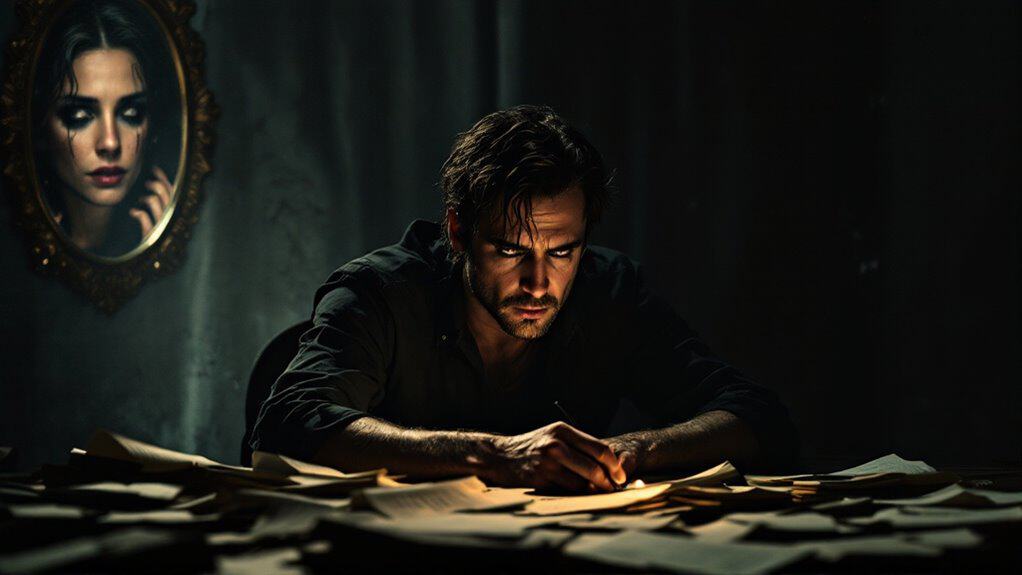Character Development in Nolan’s Storytelling
In Nolan’s storytelling, character development is intricately tied to personal struggles and moral dilemmas, often showcased through non-linear narratives that invite you to engage deeply. Each character wrestles with internal turmoil, shaping their decisions and relationships, compelling you to empathize with their journeys. Villains aren’t merely antagonists; they reflect complex psychological battles, challenging the heroes in profound ways. Furthermore, Nolan’s use of ambiguity prompts you to question ethics and motivations, blurring the lines between right and wrong. This layered approach enriches emotional depth, pulling you into a nuanced exploration of the human experience, with many facets to uncover.
Table of Contents
Key Takeaways
- Nolan’s characters are deeply influenced by their complex backstories, which shape their motivations and ethical dilemmas throughout the narrative.
- Non-linear storytelling enhances character development by revealing motivations through flashbacks and multiple perspectives, engaging audiences in their emotional journeys.
- Emotional depth is central to Nolan’s characters, showcasing internal turmoil and moral conflicts that resonate with viewers and drive character transformations.
- Ethical ambiguity permeates Nolan’s narratives, prompting characters to confront difficult moral choices that blur the lines between good and evil.
- Villains in Nolan’s films are psychologically complex, often reflecting the heroes’ internal struggles and challenging them through layered motivations and tragic transformations.
Key Principles of Character Development
When you explore character development, understanding its key principles is crucial for creating compelling narratives.
First, establish your characters’ core values and beliefs, as these shape their motivations and decisions throughout the story. A robust backstory adds depth, influencing how they interact and evolve. Character development creates multidimensional beings that enhance emotional connections within the narrative. Integrating core ethical values into your characters can further enrich their journeys and moral dilemmas.
Clear goals and stakes create investment, while a complex personality—blending strengths and weaknesses—makes your characters relatable.
It’s essential to depict character relationships authentically; these interactions can drive the plot and reveal emotional layers. Incorporating realistic dialogue and moral dilemmas will further enhance the audience’s connection.
Ultimately, balancing character development with plot progression guarantees your narrative remains engaging, allowing readers to invest in both the characters and their journeys.
Non-Linear Storytelling Techniques

Character development often intertwines with storytelling techniques, particularly when it comes to non-linear narratives. These narratives utilize non-linear timelines, presenting events out of order, which invites you to actively engage with the plot.
By employing techniques like flashbacks or reverse chronology, as seen in “Memento,” Nolan immerses you in the protagonist’s confusion. This method not only enhances your understanding of character motivations but also deepens emotional connections, as you piece together fragmented moments.
For example, “The Dark Knight” cuts between varying locations to build suspense, keeping you on your toes. Nolan’s films often showcase nonlinear storytelling as a signature style, contributing to the richness of character arcs. Additionally, this approach allows for multiple perspectives, giving audiences a deeper insight into characters’ thoughts and feelings.
Ultimately, non-linear storytelling transforms viewing into an interactive experience, encouraging you to explore complex themes and emotions while reshaping your perception of time and character growth.
Archetypes in Nolan’s Narratives

While exploring Nolan’s narratives, you’ll notice that archetypes play an essential role in shaping his characters and their journeys. These archetypes drive character resonance, showcasing their struggles through archetypal evolution. For instance, Nolan often portrays morally ambiguous figures who grapple with existential crises and complex motivations, reflecting broader societal issues. His films frequently feature nonlinear storytelling, which enhances the depth of character development by intertwining their pasts and presents in intricate ways. This approach mirrors the cyclical nature of human life experiences, emphasizing the transformative arcs of his characters as they navigate their internal and external conflicts.
| Archetype | Character Traits |
|---|---|
| The Conflicted Hero | Struggles with identity and morality |
| The Antagonistic Force | Challenges societal norms |
| The Reflective Mentor | Guides characters through crises |
Creating Complex Villains

Creating complex villains is essential in Nolan’s storytelling, as they not only challenge the heroes but also enrich the narrative with psychological depth.
Each villain is crafted with layered motivations that resonate on multiple levels, whether it’s the Joker’s chaotic desire to unmask societal norms or Bane’s calculated plan for domination. For instance, Bane’s character is significant because he is the only villain to physically overpower Batman, showcasing a unique dynamic in their conflict. This psychological depth is also evident in Nolan’s films, where characters often face profound internal struggles that shape their identities.
Take Two-Face, whose tragic transformation highlights the impact of personal loss and moral ambivalence.
These characters aren’t just antagonists; they embody intricate psychological battles that force heroes to confront their own vulnerabilities.
Character-Driven Plot Twists

When you explore character-driven plot twists in Nolan’s films, you’ll notice how purposeful foreshadowing techniques set the stage for unexpected revelations.
The actions of characters often propel these twists, creating a ripple effect that heightens emotional stakes and keeps you on the edge of your seat.
Timing plays a significant role too; the way these twists unfold can amplify their emotional impact, leaving you to rethink everything you thought you knew about the story.
Purposeful Foreshadowing Techniques
Foreshadowing serves as a powerful technique in Nolan’s storytelling, especially when it comes to character-driven plot twists. By employing various foreshadowing techniques, he weaves layers of narrative complexity that invite viewers to engage deeply with the story.
Subtle hints, like the bird cage trick in *The Prestige*, not only build anticipation but also enhance character understanding, making future revelations feel earned rather than forced. When Borden identifies a magician’s trick, it hints at his own secret, intertwining character and plot.
Nolan’s skillful use of dialogue and visual clues, as seen in *The Dark Knight*, enriches the narrative and keeps audiences invested, often prompting them to re-watch, uncovering hidden details that lead to unforgettable twists.
Character Actions Propel Twists
Character actions drive the narrative in Nolan’s films, revealing unexpected twists that reshape the viewer’s understanding. In *Memento*, Leonard’s search for his wife’s killer ultimately leads him to confront the shocking truth about himself, showcasing how his fragmented memories and actions induce unexpected outcomes.
Similarly, in *The Prestige*, the rivalry between Angier and Borden misleads the audience, culminating in the startling revelation of the cloning trick. These character actions, often influenced by flaws like self-deception or emotional turmoil, propel the plot twists.
Nolan’s non-linear storytelling enhances this effect, allowing you to gradually uncover layers of character complexity. As you engage with these narratives, you realize that each character’s journey is essential to the film’s transformative moments.
Emotional Impact Timing Strategies
While exploring emotional impact in Nolan’s storytelling, you’ll notice how timing strategies amplify character-driven plot twists. By manipulating time, Nolan creates suspense building that heightens emotional revelations, making each twist more impactful.
He often uses non-linear storytelling, reflecting a character’s perception and intensifying emotional depth. Techniques like elliptical cutting interrupt scenes, crafting unexpected shifts that leave you reeling.
Crosscutting between timelines builds tension, leading to climactic moments where revelations redefine your understanding of characters and their motivations. These strategies guarantee that when a sudden twist occurs, it resonates deeply, altering the emotional landscape and engaging you in a profound way.
Ultimately, Nolan’s timing enhances both the suspense and emotional weight of his narratives, inviting reflection.
Role of Ambiguity

Ambiguity serves as a powerful narrative tool in Nolan’s storytelling, engaging viewers by inviting them to question their perceptions of reality. His films often present characters with ambiguous motivations, blurring the lines between good and evil, which compels you to explore subjective realities.
Inception exemplifies this, providing a rich tapestry of narrative before introducing uncertainty, allowing you to ponder the nature of truth. Conversely, Tenet’s overwhelming ambiguity can muddle the plot, detracting from the experience.
Effective ambiguity requires a clear setup, as seen in Inception, where stakes are established before complexity arises. This balance enhances your engagement, prompting you to piece together themes and characters, ultimately creating a richer, more immersive viewing experience that resonates long after the credits roll.
Emotional Depth in Characters

In Nolan’s storytelling, you find a compelling exploration of internal turmoil, where characters wrestle with profound ethical dilemmas that challenge their very identities.
By analyzing their backstories, you see how past traumas shape their motivations and decisions, adding layers of emotional depth that resonate with audiences.
This intricate interplay between personal struggle and moral conflict invites you to reflect on the complexities of human nature, making each character’s journey both relatable and poignant.
Internal Turmoil Exploration
By delving into the internal turmoil of characters, Nolan crafts emotionally rich narratives that resonate deeply with audiences. His storytelling often explores the psychological burdens that weigh heavily on his characters, leading to profound internal conflict.
You can witness this through:
- Obsessive Thoughts: Characters grapple with their problems, often replaying them in their minds.
- Inner Monologues: Voiceovers, like Lenny’s in “Memento,” reveal their emotional states.
- Behavioral Changes: Shifts in actions signal their internal struggles, as seen in various films.
Nolan’s characters aren’t just facing external challenges; they navigate complex emotional layers that drive their decisions and transformations.
This exploration of internal conflict enriches their journeys, inviting audiences to connect with their vulnerabilities and triumphs on a deeply personal level.
Ethical Dilemmas Faced
While traversing the complex narratives crafted by Christopher Nolan, you’ll often find characters grappling with profound ethical dilemmas that add emotional depth to their journeys.
In films like *Memento* and *The Dark Knight Trilogy*, characters face moral ambiguity that challenges their understanding of right and wrong. For instance, Leonard Shelby’s quest for revenge raises questions about character responsibility, as his amnesia complicates his moral judgments.
Similarly, Bruce Wayne’s decisions reflect his struggle with ethical choices, impacting his identity as Batman.
In *Insomnia*, Dormer’s blurred lines between justice and personal vendetta highlight the psychological consequences of ethical dilemmas.
These conflicts not only shape their narratives but also resonate with audiences, inviting reflection on the nature of morality and responsibility.
Backstory Impact Analysis
As you explore the intricacies of character development in Nolan’s films, the impact of backstory becomes evident in shaping emotional depth. The significance of a character’s past plays a vital role in their evolution, revealing motivations that drive their actions.
Here are three key aspects of backstory impact:
- Character Motivations: Clear backstories provide context for actions, illuminating goals and fears.
- Emotional Authenticity: Well-developed backstories create multi-dimensional characters, making their struggles relatable.
- Layered Storytelling: Backstory adds complexity, enhancing thematic resonance and character relationships.
Understanding backstory significance helps you appreciate how Nolan weaves emotional stakes into his storytelling. By examining these layers, you grasp the depth of character evolution, fostering a richer connection to the narrative.
Conclusion
In Nolan’s storytelling, character development unfolds through intricate layers, revealing motivations and fears while challenging perceptions. You see heroes grappling with their flaws, villains shaped by their traumas, and plot twists that redefine relationships. Ambiguity lingers, inviting you to ponder the nature of truth and morality. Ultimately, Nolan crafts narratives that resonate emotionally, where each character’s journey mirrors a larger human experience, prompting you to reflect on your own complexities, struggles, and aspirations in life.







